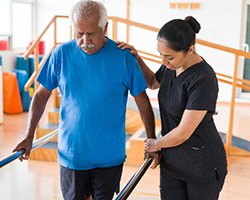 One of the keys to a successful hip replacement doesn't happen in the operating room. A program of physical therapy is a vital part of preparing for and recovering from your surgery.
One of the keys to a successful hip replacement doesn't happen in the operating room. A program of physical therapy is a vital part of preparing for and recovering from your surgery.
Before surgery
If you're a hip surgery candidate, you may have already worked with a physical therapist as part of your treatment to relieve your pain. Now, along with your doctor, a physical therapist can help you get ready for surgery too.
For example, they may show you exercises to help you get in better shape, according to the American Physical Therapy Association. These exercises may help make your lower body stronger, which can help support your new hip after surgery.
A physical therapist also may teach you to:
- Use a walker or crutches safely.
- Prepare your home so it's safer and easier for you to recover.
In the hospital
After hip surgery, physical therapy will be a very important part of your rehabilitation.
In most cases, your therapy will start while you're still in your recovery room. To begin, you might do gentle stretching and strengthening exercises in bed. And you will learn to:
- Start walking short distances with a walker or crutches.
- Stand and move to a chair.
- Use your new hip without injuring it.
These early exercises will help you recover motion and strength. And they also help increase circulation in your legs to help prevent blood clots.
After you leave the hospital
Your physical therapy will continue after you leave the hospital. It might take place in your home (if you have someone to help you safely recover there), in a short-term skilled nursing facility (if you need extra support) or in an outpatient therapy center. Plus, your therapist or doctor may give you additional exercises to do on your own at home.
You should expect to do those exercises for about 20 to 60 minutes a day for about two months after surgery and then at least two to three times a week as you continue to recover. You will likely work on things like:
- Slowly increasing your mobility.
- Getting stronger and better able to do your daily activities, like getting into bed, standing, sitting down and climbing stairs.
- Improving your balance.
Stick with it
As your strength and mobility increase, you will be able to gradually return to your daily activities, according to the American Academy of Orthopaedic Surgeons. But you will need to be patient. It can take several months of physical therapy until you are fully recovered.
You may experience some pain at first. But regular physical therapy can help you recover faster and reduce your pain.
Following your physical therapy plan will help you make the most of your new hip and get back many of the activities you love.
Reviewed 7/16/2024